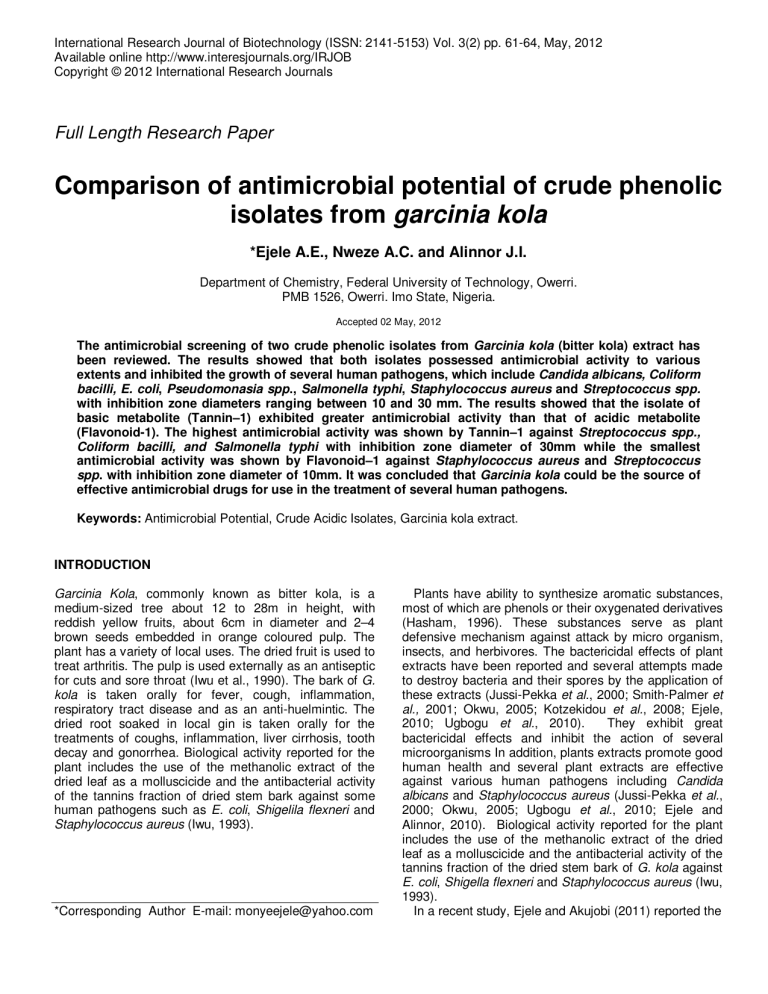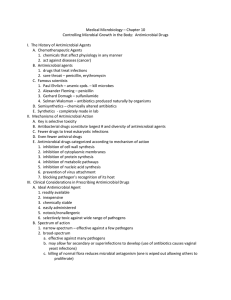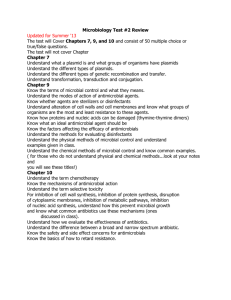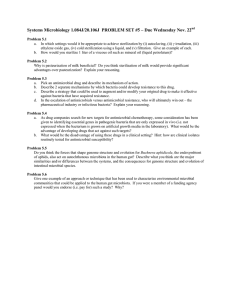International Research Journal of Biotechnology (ISSN: 2141-5153) Vol. 3(2) pp.... Available online

International Research Journal of Biotechnology (ISSN: 2141-5153) Vol. 3(2) pp. 61-64, May, 2012
Available online http://www.interesjournals.org/IRJOB
Copyright © 2012 International Research Journals
Full Length Research Paper
Comparison of antimicrobial potential of crude phenolic isolates from garcinia kola
*Ejele A.E., Nweze A.C. and Alinnor J.I.
Department of Chemistry, Federal University of Technology, Owerri.
PMB 1526, Owerri. Imo State, Nigeria.
Accepted 02 May, 2012
The antimicrobial screening of two crude phenolic isolates from Garcinia kola (bitter kola) extract has been reviewed. The results showed that both isolates possessed antimicrobial activity to various extents and inhibited the growth of several human pathogens, which include Candida albicans, Coliform bacilli, E. coli , Pseudomonasia spp ., Salmonella typhi , Staphylococcus aureus and Streptococcus spp.
with inhibition zone diameters ranging between 10 and 30 mm. The results showed that the isolate of basic metabolite (Tannin–1) exhibited greater antimicrobial activity than that of acidic metabolite
(Flavonoid-1). The highest antimicrobial activity was shown by Tannin–1 against Streptococcus spp.,
Coliform bacilli, and Salmonella typhi with inhibition zone diameter of 30mm while the smallest antimicrobial activity was shown by Flavonoid–1 against Staphylococcus aureus and Streptococcus spp . with inhibition zone diameter of 10mm. It was concluded that Garcinia kola could be the source of effective antimicrobial drugs for use in the treatment of several human pathogens.
Keywords: Antimicrobial Potential, Crude Acidic Isolates, Garcinia kola extract.
INTRODUCTION
Garcinia Kola , commonly known as bitter kola, is a medium-sized tree about 12 to 28m in height, with reddish yellow fruits, about 6cm in diameter and 2–4 brown seeds embedded in orange coloured pulp. The plant has a variety of local uses. The dried fruit is used to treat arthritis. The pulp is used externally as an antiseptic for cuts and sore throat (Iwu et al., 1990). The bark of G. kola is taken orally for fever, cough, inflammation, respiratory tract disease and as an anti-huelmintic. The dried root soaked in local gin is taken orally for the treatments of coughs, inflammation, liver cirrhosis, tooth decay and gonorrhea. Biological activity reported for the plant includes the use of the methanolic extract of the dried leaf as a molluscicide and the antibacterial activity of the tannins fraction of dried stem bark against some human pathogens such as E. coli , Shigelila flexneri and
Staphylococcus aureus (Iwu, 1993).
*Corresponding Author E-mail: monyeejele@yahoo.com
Plants have ability to synthesize aromatic substances, most of which are phenols or their oxygenated derivatives
(Hasham, 1996). These substances serve as plant defensive mechanism against attack by micro organism, insects, and herbivores. The bactericidal effects of plant extracts have been reported and several attempts made to destroy bacteria and their spores by the application of these extracts (Jussi-Pekka et al.
, 2000; Smith-Palmer et al., 2001; Okwu, 2005; Kotzekidou et al.
, 2008; Ejele,
2010; Ugbogu et al.
, 2010). They exhibit great bactericidal effects and inhibit the action of several microorganisms In addition, plants extracts promote good human health and several plant extracts are effective against various human pathogens including Candida albicans and Staphylococcus aureus (Jussi-Pekka et al.
,
2000; Okwu, 2005; Ugbogu et al.
, 2010; Ejele and
Alinnor, 2010). Biological activity reported for the plant includes the use of the methanolic extract of the dried leaf as a molluscicide and the antibacterial activity of the tannins fraction of the dried stem bark of G. kola against
E. coli , Shigella flexneri and Staphylococcus aureus (Iwu,
1993).
In a recent study, Ejele and Akujobi (2011) reported the
62 Int. Res. J. Biotechnol.
Effects of secondary metabolites of Garcinia kola on the microbial spoilage of Cajanus cajan extract and showed that the acidic metabolites of G. kola inhibited growth of the microorganisms responsible for the spoilage. In this paper, we report on the antimicrobial properties of two crude phenolic isolates from G. kola extract.
MATERIALS AND METHODS
Garcinia kola extract
65g of sun dried seeds of Garcinia kola was ground and put in a soxhlet extractor fitted with a reflux condenser and extracted with 250 mL of ethanol for 12 h. The ethanol extract was allowed to evaporate completely at room temperature to give a gel, which was dissolved in ethanol/water mixture (4:1) and filtered. The filtrate was used without further purification for the preparation of acidic and basic metabolites. Phytochemical screening of this filtrate showed presence of alkaloids, amino acids, flavonoids, fatty acids, glycosides, saponins and tannins.
Preparation of crude acidic products
Product from Basic Fraction
The basic metabolite was prepared as earlier stated
(Ejele and Alinnor, 2010). The filtrate from Garcinia kola extract was treated with dilute HCl and extracted with chloroform in a separating funnel. The lower chloroform layer was removed (and reserved for the preparation of other metabolites). The HCl layer was treated with dilute
NaOH solution until the mixture became basic. The mixture was allowed to stand overnight and filtered. The filtrate was made acidic by the addition of conc H
2
SO
4 and allowed to stay overnight and the crude acidic precipitate (called Tannin–1 ) was removed, washed with distilled water and allowed to dry in air. This reddishbrown precipitate was used for the antimicrobial experiments without further purification. Chemical tests showed the precipitate could be a carboxylic acid or phenol while phytochemical screening showed the crude precipitate could be a polyphenol, (probably a tannin).
Product from Acidic Fraction
The acidic metabolite was prepared as earlier stated
(Ejele and Alinnor, 2010). The filtrate from Garcinia kola extract was treated with dilute HCl and extracted with chloroform in a separating funnel. The upper HCl layer was discarded and lower chloroform layer was taken, placed in a separating funnel and treated with dilute
NaOH solution. After equilibrating, the lower chloroform layer was removed and the aqueous alkaline layer was treated with dilute HCl until the solution became acidic and a reddish brown precipitate (Flavonoid–1) was formed, washed with distilled water and allowed to dry in air at room temperature. Chemical tests showed the precipitate could be a carboxylic acid or phenol while phytochemical screening showed the crude precipitate could be a polyphenolic compound, (probably a flavonoid).
Antimicrobial screening test of phenolic isolates
This experiment was carried out at the Department of
Microbiology, Federal Medical Centre, Owerri, Imo State,
Nigeria, as earlier described by Garred and O. Graddy
(1983). An inoculating loop or needle was touched to four or five isolated colonies of the pathogen growing on agar and then used to inoculate a tube of culture broth. The culture was incubated for a few hours at 35-37 o
C until it became slightly turbid and was diluted to match a turbidity standard.
A sterile cotton swab was dipped into the standardized bacterial test suspension and used to evenly inoculate the entire surface of an agar plate. After the agar surface has dried for about 5 min, the appropriate antibiotic test disks were placed on it with a multiple application device and the plate was immediately placed in an incubator maintained at 35–37 o
C. After 16–18h of incubation, the diameters of the zones of inhibition were measured and presented to the nearest mm (Table 2).
RESULTS AND DISCUSSION
The phytochemical analysis of the two crude acidic isolates obtained from Garcinia Kola extract showed the presence of tannins and flavonoids while chemical tests showed the presence of free phenols, carboxylic acids,
(Table 1). When compared with the crude ethanol extract, it was observed that the alkaloids and glycosides
(including saponins) were not found in the acidic metabolites, although they were present in the crude extract. All other phytochemicals screened were present in both samples.
The antimicrobial screening tests (presented in Table
2) showed that both isolates possessed antimicrobial activity to various extents and inhibited the growth of several human pathogens including Coliform bacilli , E. coli , Staphylococcus aureus, Pseudomonasia spp .,
Salmonella typhi, etc with diameters of zones of inhibition which ranged between 10 and 30 mm.
Generally it was observed from Table 2 that the polyphenolic product obtained from the basic metabolite
(Tannin–1) exhibited greater antimicrobial activities against the microorganisms than Flavonoid–1, obtained from the acidic metabolite. The greatest antimicro- bial activity of Tannin–1 was against Streptococcus spp.,
Ejele et al. 63
Table 1. Chemical / Phytochemical Screening
Compound Phenolic Products Crude Extract
Alkaloids
Tannins
Flavonoids
Saponins
Steroids
Glycosides
Aldehydes / Ketones
Terpenoids
Amino acids
Carboxylic acids
–
++
++
–
–
–
–
–
+
Phenols +++
Esters –
– Absent; +++ Abundant; ++ Moderate: + Low
Table 2. Results of screening tests against pathogens.
+
++
+++
++
–
++
–
–
++
++
ORGANISMS
Staphylococcus aureus
Streptococcus spp
Coliform bacilli
E. Coli
Salmonella typhi
Product from acidic metabolite
(Flavonoid – 1)
Zone of Inhibition (mm)
10
10
11
20
20
Product from basic metabolite
(Tannin – 1)
Zone of Inhibition (mm)
28
30
30
25
30
Pseudomonasia spp 12 22
Candida albicans 18 20
Coliform bacilli and Salmonella typhi with inhibition zone diameter of 30mm while the smallest antimicrobial activity was against Candida albicans with inhibition zone diameter of 20mm. For the Flavonoid–1, the greatest antimicrobial activity was against E. coli and Salmonella typhi with zone of inhibition of 20mm while the smallest
Since the middle ages, plant extracts and oils have been used widely for bactericidal, fungicidal, virucidal, antiparasitic, insecticidal, medicinal and cosmetic purposes. Even now they are employed in sanitary, pharmaceutical, cosmetic, agricultural and food industries
(Bakkali et al.
, 2008). These plant oils, in which the antimicrobial activity was against and Streptococcus spp
10mm.
Adeleke et al., earlier reported similar antimicrobial activities of extracts against
Staphylococcus aureus with inhibition zone diameter of
(2006) and Ugbogu et al.,
Straphylococcus aureus
(2010) had
G. kola
, whose strains carry a wide range of multidrug resistance genes, which odouriferous and flavouring characteristics are concentrated, have preservative effects when added to foods (Broughall and Brown, 1984) and usually contained esters, terpenes, terpenoids, flavonoids and other phenol-derived aromatic and aliphatic compounds, most of which act as antioxidants. Results of antibacterial tests have shown that plant oils inhibited the growth of several human pathogens to different extents (Cimanga et al., may be exchanged and spread throughout the world among different species of the fungi. Methicillin resistant
Straphylococcus aureus is a major cause of hospital acquired infections (Trease and Evans, 2002; Vindel et al.
, 2009; Boyce et al., 2005). The relatively large zone of inhibition reported for G. kola extract against
2002).
The antioxidant properties of essential oils are well known and have been documented (Jussi-Pekka et al ,
2000; Smith-Palmer et al.
, 2001; Cimanga et al.
, 2002;
Bakkali et al.
, 2008; Kotzekidou et al.
, 2008) and plant
Straphylococcus aureus has led several authors and researchers to conclude that G. kola could be the source phenols are currently of growing interest because they promote human health. Jussi-Pekka et al.
, (2000) carried of an effective antimicrobial drug for use against Straphylococcus aureus (Iwu, 1993; Okwu, 2005; and 29 plant extracts against selected microbes and
Adeleke et al., 2006; Ugbogu et al., 2010). found that many phenolic compounds (such as flavone,
64 Int. Res. J. Biotechnol. quercetin and naringenin) were active and inhibited the growth of gram-positive Staphylococcus aureus and other microorganisms.
Chemical tests showed the crude precipitate could be a carboxylic acid or polyphenol, yet we cannot say for certain what the product could be. However, we speculate that a polyphenol (flavonoid or tannin) could be the active principle responsible for the observed antimicrobial and antioxidant properties of the product because: i) it dissolved freely in NaOH solution but was insoluble in aqueous Na
2
CO
3
; ii) when treated with FeCl
3
solution, a reddish-brown precipitate was obtained.
These reactions are characteristic of phenols and not carboxylic acids. Moreover, polyphenols have been shown to possess bactericidal, fungicidal, virucidal, antiparasitical, insecticidal, medicinal and antioxidant properties (Jussi-Pekka et al.
, 2000; Smith-Palmer et al.
, 2001; Cimanga et al.
,
2002; Bakkali et al.
, 2008; Kotzekidou et al.
, 2008).
Therefore more work will be done to isolate and characterize the bioactive compound responsible for the observed effects.
CONCLUSION
The antimicrobial properties of two crude phenolic isolates from Garcinia kola (bitter kola) extract were compared. The results showed that both isolates possessed antimicrobial activity to various extents and inhibited the growth of several human pathogens, such as: Candida albicans, Coliform bacilli, E. coli ,
Pseudomonasia spp ., Salmonella typhi, Staphylococcus aureus and Streptococcus spp.
Tannin–1 showed inhibition zone diameters ranging between 20-30 mm and exhibited high antimicrobial activity against
Staphylococcus aureus with inhibition zone diameter of
28mm. In view of the prevalence of Straphylococcus aureus in the society, it was concluded that Garcinia kola could be a source of an effective antimicrobial drug for use in the treatment of diseases caused by this organism and recommended that attempts be made to isolate, purify, characterize and produce a standardized antimicrobial drug from Garcinia kola extract.
REFERENCES
Adeleke OE, Afolabi RO, Adekunle IM, Ojo OP (2006). “Antimicrobial activities of extracts of Garcinia kola seed on agents of respiratory tract infections”. Nig. J. Microbiology: 20, 1185 – 1190.
Bakkali F, Averback S, Averback D, Idaomar M (2008). “Biological effects of essential oils–A review”. Food Chem. Toxicol. 46, 446 –
475.
Boyce JM, Cookson B, Christianisen K, Hori S, Vuopio-Varkila I,
Kocagos S, Oztop AY, Vanderbrouke-Graul CM, Harbarth S, Pittet D
(2005). “Meticillin resistant Straphylococcus aureus ”. Lancet: 5, 653 –
663.
Broughall JM, Brown C (1984). “Hazard analysis applied to microbal growth in foods: development and application of three – dimensional models to predict microbial growth.” Food Micro.1,13 – 22.
Cimanga K, Kambu K, Tona L, Apers S, De Bruyne T, Hermans N,
Totte J, Pieters L, Vlietinck A J (2002). “Correlation between the chemical composition and antibacterial activity of essential oils of some aromatic medicinal plants growing in the Democratic Republic of Congo”. J. Ethnopharm: 79, 213 – 220.
Ejele AE (2010). Effect of some plants extracts on the microbial spoilage of Cajanus cajan . Inter J. Trop. Agric. Food Sys: 4(1): 46 –
49.
Ejele AE, Akujobi CO (2011). Effects of Secondary Metabolites of
Garcinia kola on the Microbial Spoilage of Cajanus cajan extract”.
Inter J. Trop. Agric. Food Sys: 5(1): 8 – 14
Garred LP, Graddy OF (1983). Antibiotics and Chemotherapy. 4 th edition. Churchill Livingstone Publishers. London. p. 189.
Hasham E (1996). “Natural Polyphenols (vegetable tanninoids) as drugs:: possible modes of actions”. J. Nat Prod: 59, 205 – 215.
Iwu MM (1993). “Handbook of African Medicinal Plants”. CRS Press Inc.
Florida. pp. 33 – 35.
Iwu MM, Igboko AO, Elekwa DR, Tempesta MS (1990). “Biflavonoid constitutents of Garcinia Kola roots”. Fitoterapia: 61(2): 178 -181
Jussi-Pekka Rauha, Susanna Remes, Marina Heinonen, Anu Hopia,
Marja Kahkonen, Tytti Kujala, Kalevi Pihiaja, Heikki, Pia Vuorela
(2000). “Antimicrobial effects of Finnish Plant extracts containing
Flavonoids and other phenolic compounds”. Inter J. Food
Microbiology: 58, 3 – 12.
Kotzekidou P, Giannakidis P, Boulamatsis A (2008). “Antimicrobial
Activity of some plant extracts and essential oils against foodbourne pathogens in vitro and on the face of inoculated pathogens in chocolate”. LWT – Food Sc. Tech: 41, 119 – 127.
Okwu DE (2005). “Phytochemical, vitamin and mineral contents of two
Nigerian Medicinal plants”. Inter J. Mol. Med. Sc: 1 (14), 372 – 381.
Smith-Palmer A, Stewart J, Fyfe L (2001). “Potential application of plant essential oils as natural food preservatives in soft cheese”. Food
Microbiology: 18, 463 – 470.
Ugbogu OC, Ahuama OC, Atusiuba S, Okorie JE (2010). “Methicillin
Resistant Staphylococcus aureus (MRSA) Amongst Students and
Susceptibility of MRSA to Garcinia kola Extracts”. Nig. J.
Microbiology: 24 (1), 2043 – 2047.
Vindel A, Cuevas O, Cemado E, Marcos C, Bautista V, Castellares C,
Princado P, Boquete T, Perez-Vazquez M, Bouza E, the Spannish group for the study of Straphylococcus (2009). “Meticillin Resistant
Straphylococcus aureus in Spain. Molecular epidemiology and utility of Different Typing Methods”. J. Clin. Microbiology: 47 (16), 1620 –
1627.







